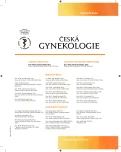Specific placental complications of monochorionic diamniotic twins born after 24 weeks of pregnancies – restrospective analysis
Authors:
I. Vlašínová; Lukáš Hruban
; Petr Janků
; Romana Gerychová; P. Ventruba; Veronika Ťápalová
; Z. Hodická
Authors‘ workplace:
Gynekologicko-porodnická klinika LF MU a FN, Brno, přednosta prof. MUDr. P. Ventruba, DrSc., MBA
Published in:
Ceska Gynekol 2015; 80(3): 189-195
Overview
Objective:
Purpose of this study was to determine the frequency of occurence of specific complications of monochorionic diamniotic twins born after 24 weeks of pregnancies and the effect of these complications on perinatal morbidity and mortality.
Type of study:
Restrospective analysis.
Setting:
Dpt. of Obstetrics and Gynecology Masaryk University and University Hospital Brno.
Methodology:
A retrospective analysis of 175 monochorionic diamniotic pregnancies (mo-bi), which were terminated after the 24th week of pregnancy at the Department of Obstetrics and Gynecology Masaryk University and University Hospital Brno between the years 2008–2013. The specific complications such as twin-to-twin syndrome (TTTs), twin anemia polycytemia sequens (TAPS), selective intrauterine growth restriction (sIUGR), twin-arterial revers perfusion sequence (TRAP), single intrauterine fetal death (IUFD), placental insufficiency with both twins were identified using prenatal ultrasound examinations, perinatal results and the result of pathological anatomical examinations. Perinatal morbidity, neonatal mortality and neurological development were evaluated. The numbers of late detections of specific complications were observed.
Results:
Specific complications in our group were identified in 50 pregnancies (28.6%). TTTs was diagnosed most often, by 18 pregnancies (10.3%), next most frequent diagnosis were sIUGR (9.7%) and TAPS (3.4%). The placental insufficiency with both twins complicated 2.6% pregnancies. 10 children had abnormal neurological development. Pregnancies with late detection had the worst perinatal results. No acute TTTs during delivery was detected.
Conclusion:
Specific placental complication reached 29.7% in our file. The most frequent complication was TTTs (10.3%) and selective growth restriction (9.7%). Pregnancies with late diagnosis of these complications had the worst results. The prenatal care by monochorial biamnial pregnancies should be at specialized centres from the 16th week of pregnancy every two weeks.
Keywords:
monochorionic diamniotic twins, twin-to-twin syndrome, twin anemia polycytemia sequence, twin-arterial revers perfusion sequence, selective intrauterine growt restrictions
Sources
1. Barigye, O., Pasquini, L., Galea, P., et al. High risk of unexpected late fetal death in monochorionic twins despote intensive ultrasound surveillance: A cohort study. PLoS Med, 2005, 2(6): e172. doi:10.1371/journal.pmed.0020172.
2. Baschat, AA., Oepkes, D. Twin anemia-polycythemia sequence in monochorionic twins: implications for diagnosis and treatment. Am J Perinatol, 2014,1, p. 25–30.
3. Breslin, E., Khare, M. Perinatal outcomes in planned vaginal deliveries of monochorionic-diamniotic twins. Arch Dis Child Fetal Neonatal Ed, 2014, 99, Suppl. 1, p. A159.
4. Gerychová, R., Račanská, E., Janků, P. TRAP (Twin reversed arterial perfusion) syndrome. http://sonoworld.com/TheFetus/page.aspx?id=2714.
5. Glinianaia, SV., Rankin, J., Wright, C. Congenital anomalies in twins: a register-based study. Hum Reprod, 2008, 23, p. 1306–1311.
6. Hack, KEA., Derks, JB., Elias, SG., et al. Perinatal mortality and mode of delivery in monochorionic diamniotic twin pregnancies ≥32 weeks of gestation: a multicentre retrospective cohort study. BJOG, 2011, 118, p 1090–1097.
7. Hájek, Z., a kol. Rizikové a patologické těhotenství. Praha: Grada Publishing, 2004, 327 s.
8. Hillman, SC., Morris, RK., Kilby, MD. Co-twin prognosis after single fetal death: a systematic review and meta-analysis. Obstet Gynecol, 2011, 118, 4, p. 928–940.
9. Hodík, K., Musilová, I., Kopecký, P., et al. Syndrom twin-to-twin transfuze – nové metody léčby zlepšující přežití. Gynekol po promoci, 2007, 3, s. 65–72.
10. Hoffmann, E., Oldenburg, A., Rode, L., et al. Twin births: cesarean section or vaginal delivery? Acta Obstet Gynecol Scand, 2012, 91, p. 463–469.
11. Chang, YL., Chao, AS., Chang, SD., et al. The neurological outcomes of surviving twins in severe twin-twin transfusion syndrome treated by fetoscopic laser photocoagulation at a newly established center. Prenat Diagn, 2012, 32, p. 893–906.
12. Kilby, M., Baker, P., Critchley, H., Field, D. Multiple pregnancy. London: RCOG Press, 2006, p. 283–286.
13. Lewi, L., Gucciardo, L., Huber, A., et al. Clinical outcome and placental characteristics of monochorionic diamniotic twin pairs with early – and late on set discordant growth. Am J Obstet Gynecol, 2008, 199, p. 511.e1–511.e7.
14. Lewi, L., Gucciardo, L., Mighem, TV., et al. Monochorionic diamniotic twin pregnancies: Natural history and risk stratification. Fetal diagn Ther, 2010, 27, p. 121–133.
15. Lewi, L., Van Schoubroeck, D., Gratacós, E., et al. Monochorionic diamniotic twins: complications and management options.Curr Opin Obstet Gynecol, 2003, 15, p. 177–94.
16. Lopriore, E., Middeldorp, JM., Klumper, FJ., et al. Twin anemia-polycytemia sequence in two monochorionic twin pairs without polyhydramnios sequence. Placenta, 2007, 28, p. 47–51.
17. Quintero, RA., Dickinson, JE., Morales, WJ., et al. Stage-based treatment of twin-twin transfusion syndrome. Am J Obstet Gynecol, 2003, 188, 5, p. 1333–1340; 2013, 208, p. 3–18.
18. Slaghekke, F., Kist, WJ., Oepkes, D., et al. Twin anemia-polycytemia sequence: diagnostic criteria, clasification, perinatal management and outcome. Fetal diagn Ther, 2010, 27, p. 181–190.
19. Tosello, B., Blanc, J., Haumonté, JB., et al. Short and medium-term outcomes of live-born twins after fetoscopic laser therapy for twin-twin transfusion syndrome. J Perinat Med, 2014, 42, p. 99–105.
20. Weisz, B., Hogen, L., Yinon, Y., et al. Mode of delivery and neonatal outcome in uncomplicated monochorionic twin pregnancies. J Matern Fetal Neonatal Med, 2012, 25, p. 2721–2724.
Labels
Paediatric gynaecology Gynaecology and obstetrics Reproduction medicineArticle was published in
Czech Gynaecology

2015 Issue 3
Most read in this issue
- Prevention of preeclampsia – review
- The importance of irregular red cell antibodies screening and blood group antigens assessment in pregnant women
- Specific placental complications of monochorionic diamniotic twins born after 24 weeks of pregnancies – restrospective analysis
- Ectopia cordis – case report
